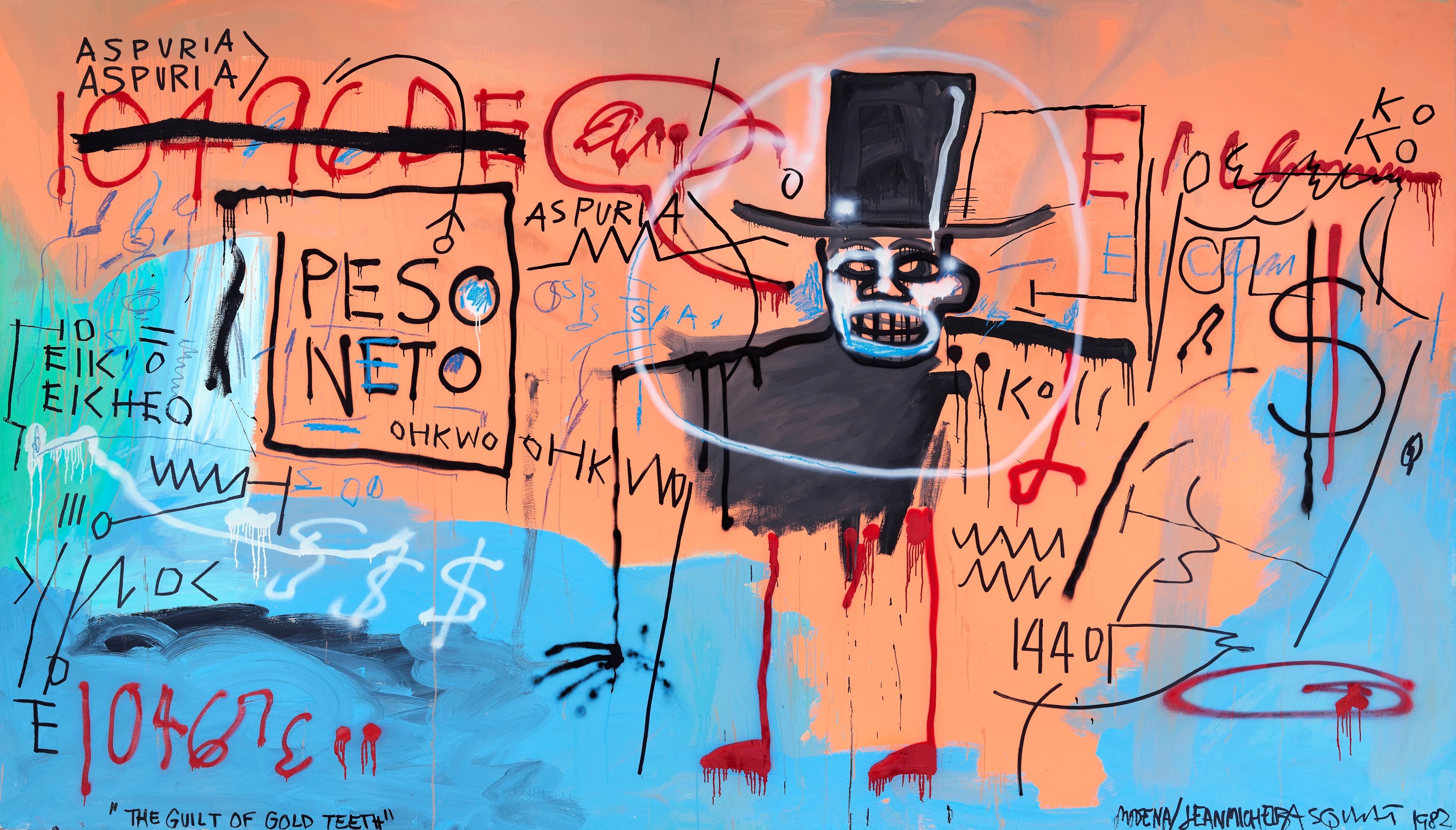The Fondation Beyeler is now presenting “Basquiat. The Modena Paintings”, eight large-scale works that Jean- Michel Basquiat painted in 1982 in Modena, Italy for an exhibition that in the end never took place. More than 40 years later and for the first time, Fondation Beyeler reunites eight masterpieces, now held in private collections in the United States, Asia and Switzerland, which comprise Basquiat’s most celebrated and valuable works. The exhibition comes 13 years after the Fondation Beyeler mounted a comprehensive retrospective devoted to the artist. Jean-Michel Basquiat (1960–1988) ranks among the most significant artists of the late 20th century. He shot to international fame in the early 1980s, as figurative painting experienced a renaissance. One of the art world’s most flamboyant personalities, Basquiat started out in the New York underground scene as a graffiti poet and musician before fully devoting himself to visual art. His highly expressive paintings, bursting with energy, soon gained widespread admiration. Aged only 21, he was the youngest artist invited to take part in Documenta 7, held in Kassel in the summer of 1982. Championed by Andy Warhol, he advanced to international art stardom. As the son of a Haitian father and a mother born to Puerto Rican parents, he was the first Black artist to break through in an art world dominated by white protagonists. In addition to Andy Warhol, Basquiat also worked with Keith Haring, Francesco Clemente and Debbie Harry among other artists and musicians. Up to his sudden death in August 1988 and over the course of less than a decade, he produced an extensive body of work comprising more than 1000 paintings and objects as well as 3000 works on paper.  Jean-Michel Basquiat, UNTITLED (DEVIL), 1982. Acrylic and spray paint on canvas, 238.7 x 500.4 cm. Private Collection. © Estate of Jean-Michel Basquiat. Licensed by Artestar, New York. Photo: © 2023 Phillips Auctioneers LLC. All Rights Reserved. Following the heyday of conceptual and minimal art in the 1960s and 1970s, Basquiat succeeded in establishing a new figurative and expressive formal idiom. His works, populated with comic-like figures, skeleton silhouettes, odd everyday objects and poetic slogans, are vibrantly colourful and richly potent, merging motifs derived from pop culture and cultural history, as well as political and economic themes, into a critical commentary of consumer society and social injustice, in particular racism. Basquiat held his first solo show in 1981 at the Galleria d’Arte Emilio Mazzoli in Modena, still under the pseudonym SAMO©, which had originated in his collaboration with graffiti artist Al Diaz. Basquiat had come to the attention of Italian gallery owner Emilio Mazzoli just a few months earlier at the group show “New York / New Wave” curated by Diego Cortez at P.S. 1 Contemporary Art Center (now MoMA PS1) in Long Island City. In Modena, Emilio Mazzoli provided Basquiat with work premises and painting supplies to produce new works. In the early summer of 1982, at Mazzoli’s invitation, Basquiat returned to Modena for his first European exhibition under his real name. In Modena, Mazzoli made a warehouse available to artists to work in. Among these artists was Mario Schifano, who over several years regularly came to Modena to paint. When Basquiat arrived in the city, he came upon several finished paintings by Schifano, as well as primed and blank canvases. Their monumental dimensions appealed to him and he used them for his own work. Basquiat thus produced a group of paintings each measuring at least two by four metres, all larger than and unlike anything he had painted to that day. By inscribing the back of the canvases with the indication “Modena” and his signature, he identified them as a cohesive group of works. Disagreements between art dealers Annina Nosei (who had been Basquiat’s representative in New York since late 1981) and Emilio Mazzoli led to the cancellation of the planned exhibition in Modena. In a 1985 interview with the New York Times, Basquiat expressed frustration when looking back on his second stay in Modena: “They set it up for me so I’d have to make eight paintings in a week”, and working in the provided warehouse premises felt to him “like a factory, a sick factory. I hated it.” In the end, Mazzoli paid Basquiat for the works he had produced and the artist returned to New York. The eight canvases painted in Modena eventually found new owners through Annina Nosei. Bruno Bischofberger bought four paintings (Profit I, Boy and Dog in a Johnnypump, Untitled [Woman with Roman Torso (Venus)], The Guilt of Gold Teeth), while the other four entered various international collections. Today, all eight paintings are held in different private collections in the United States, Asia and Switzerland. While some of them have occasionally been reunited in retrospectives, others have only rarely been publicly shown. The exhibition project originally conceived by Emilio Mazzoli has not been studied and covered in any depth to date. And yet, not only are the paintings produced in Modena among the most significant in Basquiat’s oeuvre and arguably some of the most valuable contemporary artworks to have been made by an artist altogether; the ultimately aborted project idea also constitutes a significant event in Basquiat’s artistic career. The Modena cycle The “Modena Paintings” share several motifs and stylistic features: all eight works are dominated by a monumental, often black figure set against a background of broad, gestural and expressive brushstrokes. Untitled (Angel) and Untitled (Devil), operating as a quasi-diptych, feature the eponymous figures of an angel and a devil as bust portraits with both arms raised – a posture that can be understood as both pleading and triumphant, and that is not only repeated in other paintings of the Modena cycle but more generally recurrent in Basquiat’s oeuvre. The skeleton suggested with rough horizontal strokes in Untitled (Devil) as well as the skull with deep eye sockets and nasal cavities also define the figures in Boy and Dog in a Johnnypump and The Field Next to the Other Road. Another trademark of Basquiat’s figures is the headdress, sometimes a halo and sometimes a crown of thorns, also featured in Untitled (Woman with Roman Torso [Venus]) and Profit I. Compared to the other works in the group, these last two paintings along with The Guilt of Gold Teeth display a greater density of Basquiat’s typical “scribbles”. The Guilt of Gold Teeth in particular, with its cryptic words, number combinations and dollar signs, prefigures later developments in his work. With Untitled (Cowparts), which features a larger-than-life cow with striking round eyes, the Modena cycle comes full circle insofar as the thick white brushstrokes used in Untitled (Angel) to accentuate the black body now trace the animal’s outline. With the exceptions of Profit I and The Guilt of Gold Teeth, in which the combination of acrylic, spray paint and oil stick establishes a dialogue with the medium of drawing, the Modena cycle emphasises painterly aspects. The visual collage of various images and words, otherwise so characteristic of Basquiat, is only on limited display. Overall, the Modena repertoire is less detailed and fragmented, and focuses on larger, more expansive depictions. The human and the animal body take centre stage. Unlike earlier works, the “Modena paintings” do not feature the impressions of big city streets usually favoured by Basquiat. Several of the eight paintings display the same hues, seen for example in the flat expanses of their backgrounds, as well as a similar use of loud red brushstrokes to emphasise the depicted figures. It was Basquiat’s practice to work on several canvases at once, as the different paint layers needed time to dry. |
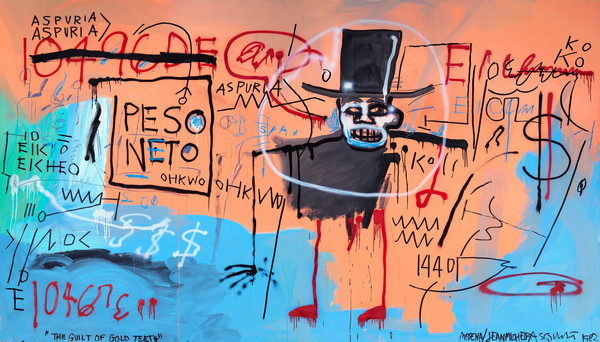
JEAN-MICHEL BASQUIAT, THE GUILT OF GOLD TEETH, 1982
Acrylic, spray paint and oilstick on canvas, 240 x 421,3 cm
Nahmad Collection
© Estate of Jean-Michel Basquiat. Licensed by Artestar, New York
Photo: Annik Wetter
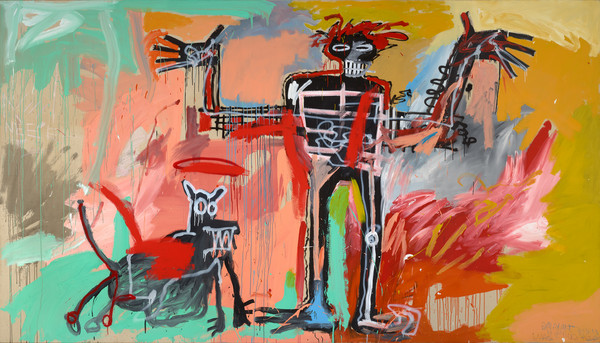
JEAN-MICHEL BASQUIAT, BOY AND DOG IN A JOHNNYPUMP, 1982
Acrylic, oil stick, and spray paint on canvas; 240 x 420.4 cm
Private Collection
© Estate of Jean-Michel Basquiat. Licensed by Artestar, New York
Photo: Daniel Portnoy
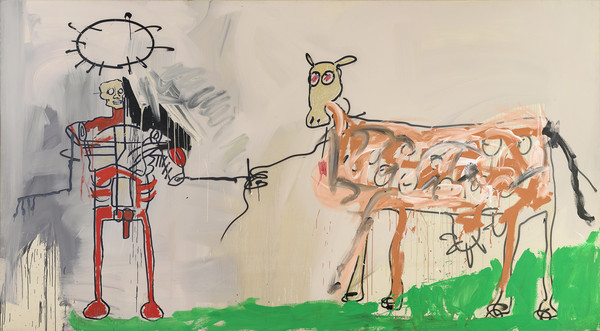
JEAN-MICHEL BASQUIAT, THE FIELD NEXT TO THE OTHER ROAD, 1982
Acrylic, enamel paint, spray paint, oil stick, and ink on canvas, 221 x 401.5 cm
Private Collection
© Estate of Jean-Michel Basquiat. Licensed by Artestar, New York
Photo: Adam Reic
![Jean-Michel Basquiat, Untitled (Woman with Roman Torso [Venus]), 1982](https://www.fondationbeyeler.ch/fileadmin/_processed_/1/c/csm_Basquiat_Venus-1982_LAC_300x171mm_9f20471d96.jpg)
JEAN-MICHEL BASQUIAT, UNTITLED (WOMAN WITH ROMAN TORSO [VENUS]), 1982
Acrylic and oil stick on canvas, 241 x 419.7 cm
Private Collection
© Estate of Jean-Michel Basquiat. Licensed by Artestar, New York
Photo: Robert Bayer
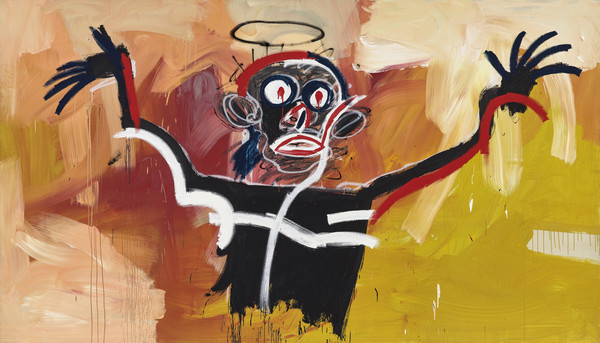
JEAN-MICHEL BASQUIAT, UNTITLED (ANGEL), 1982
Acrylic and spray paint on canvas, 244 x 429 cm
Private Collection
© Estate of Jean-Michel Basquiat. Licensed by Artestar, New York
Photo: Robert Bayer
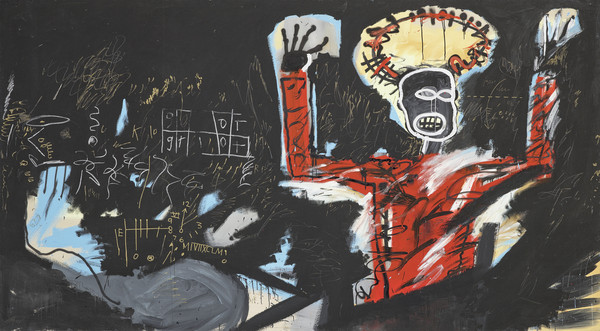
JEAN-MICHEL BASQUIAT, PROFIT 1, 1982
Acrylic, oil stick, marker, and spray paint on canvas, 220 x 400 cm
Private Collection, Switzerland
© Estate of Jean-Michel Basquiat. Licensed by Artestar, New York
Photo: Robert Bayer
